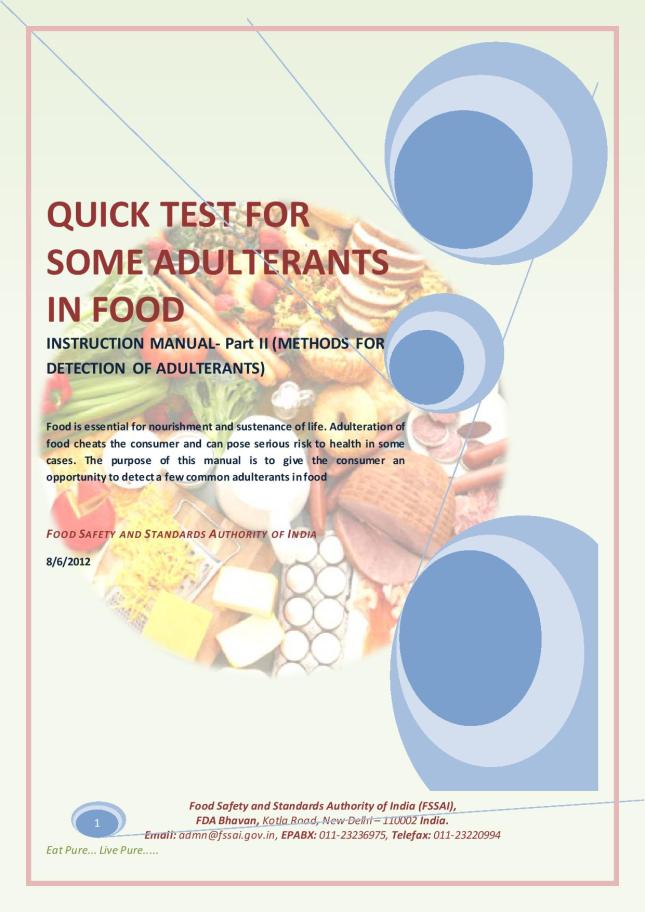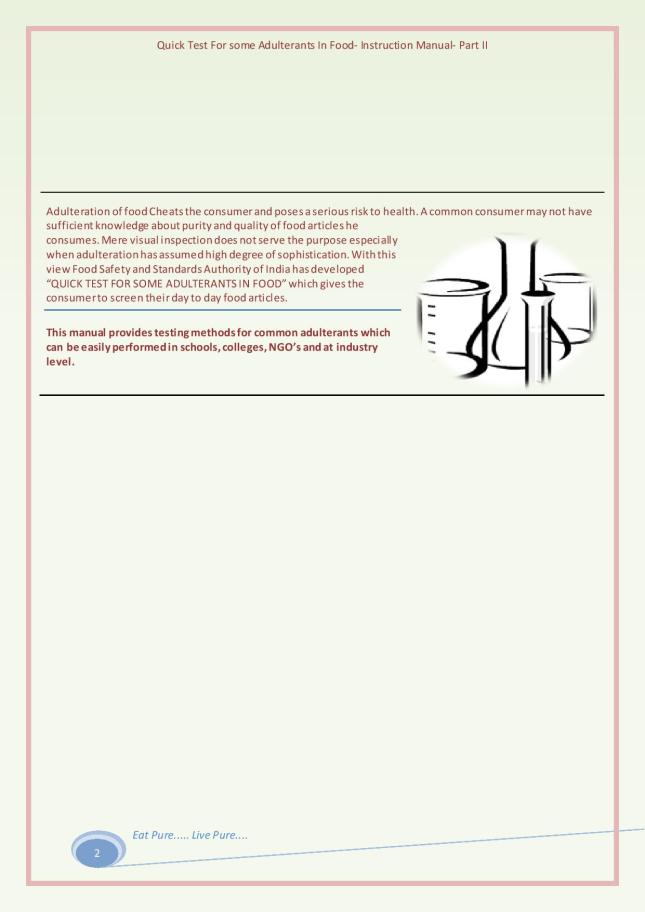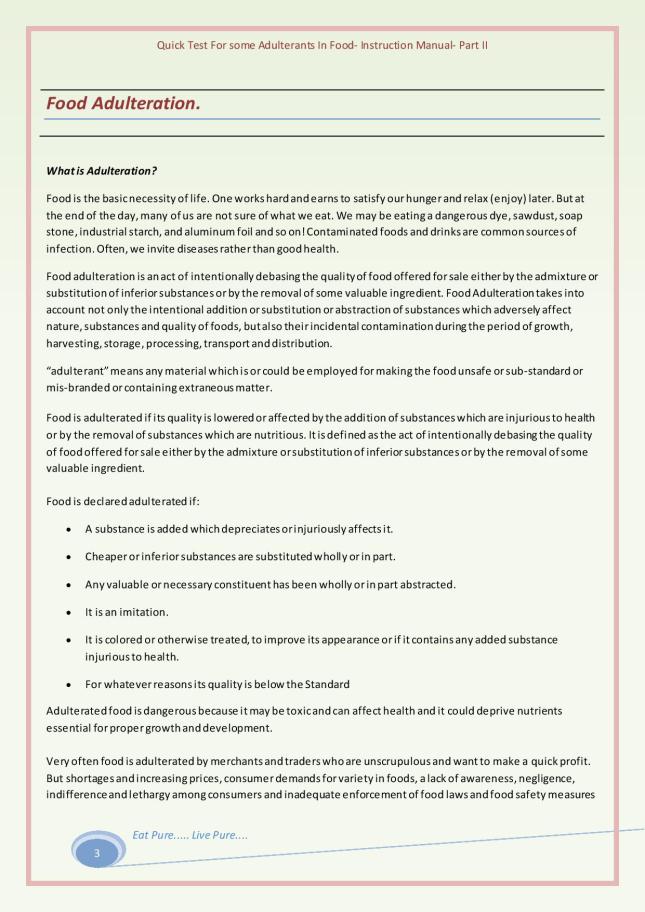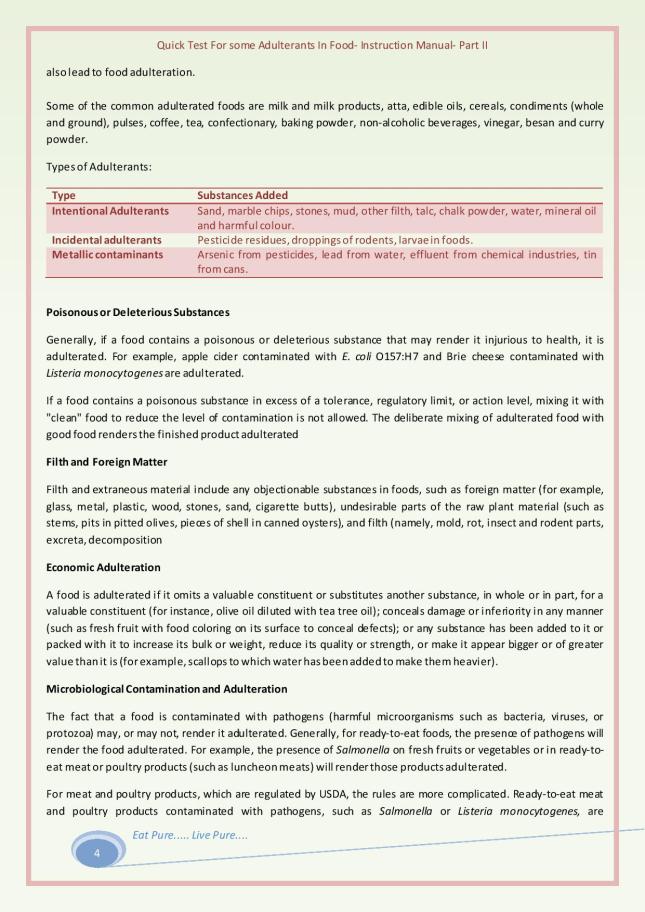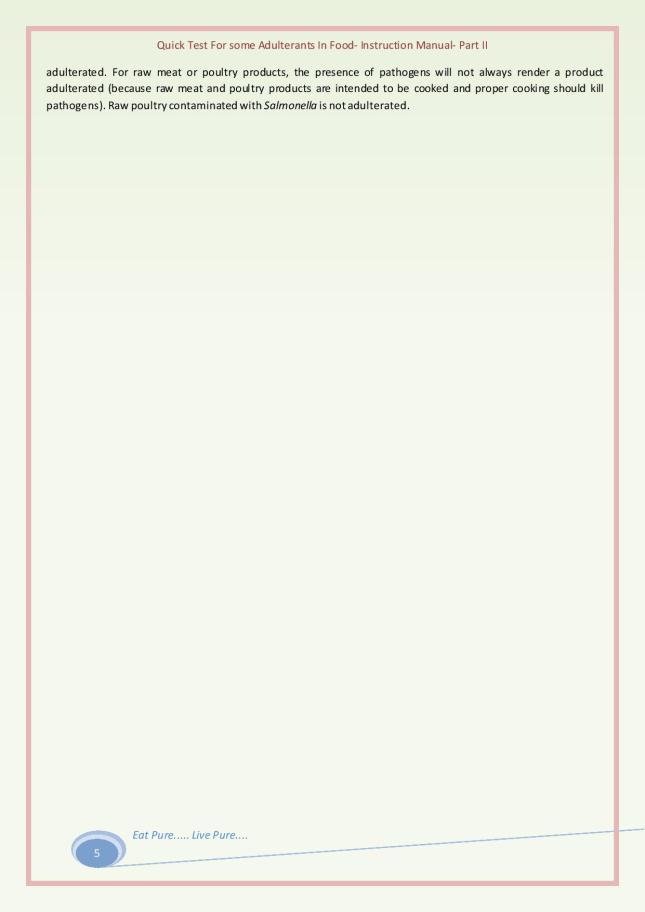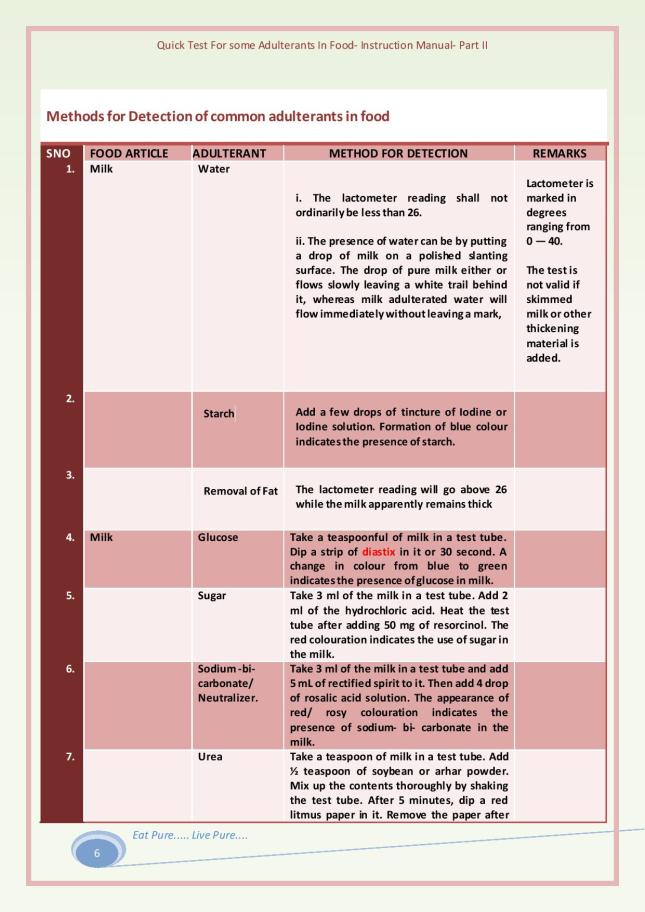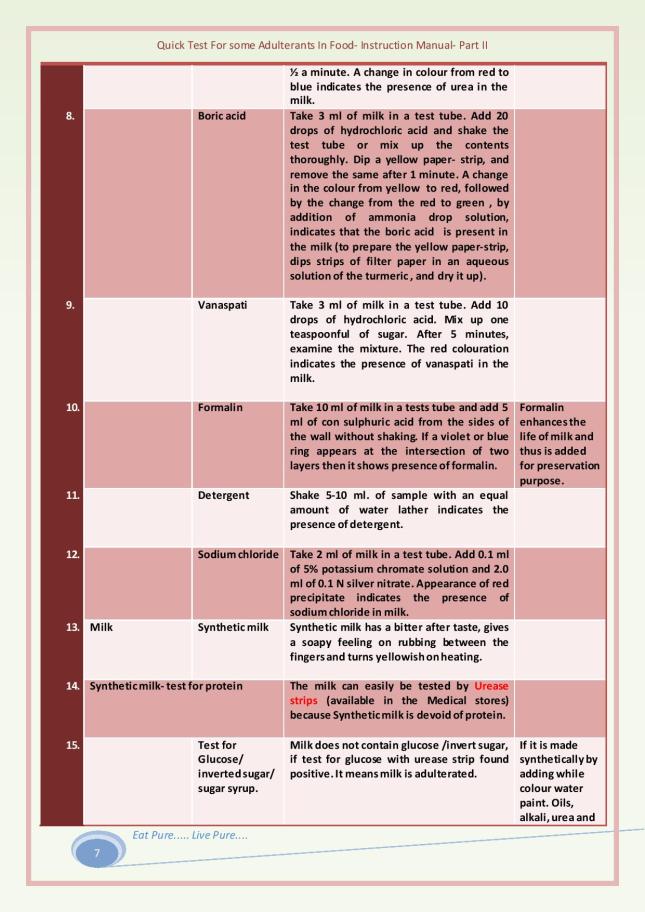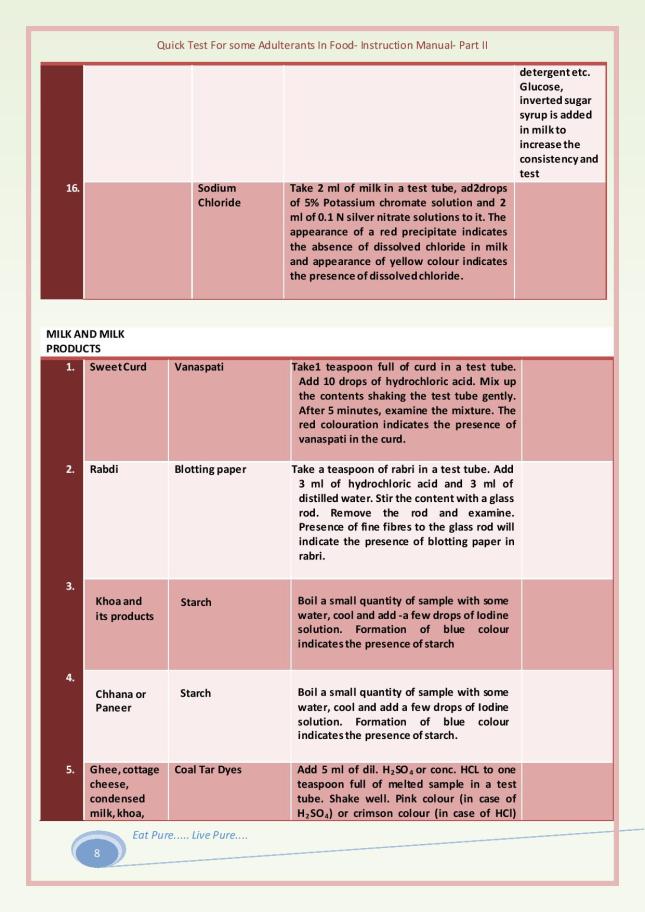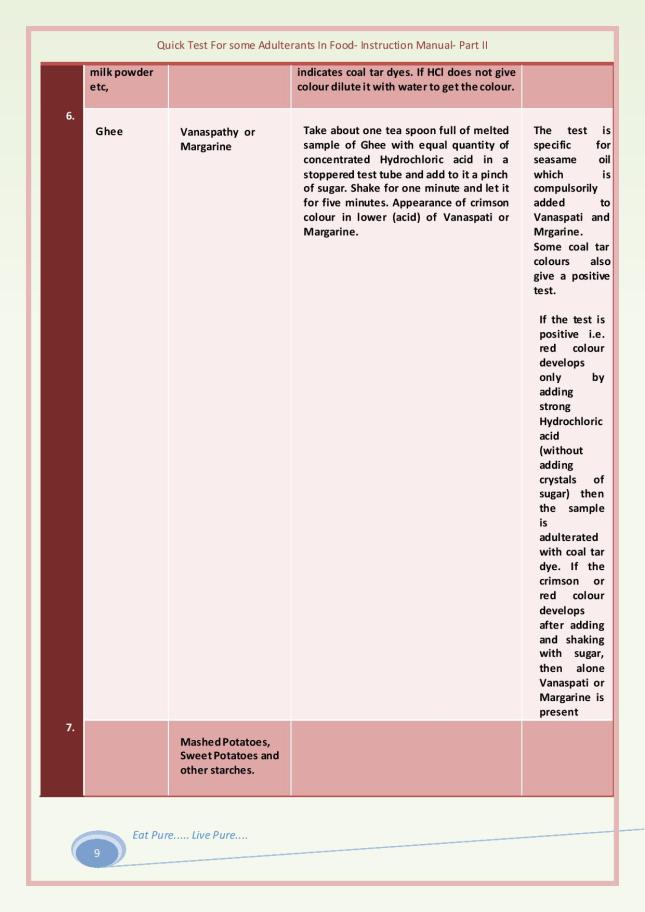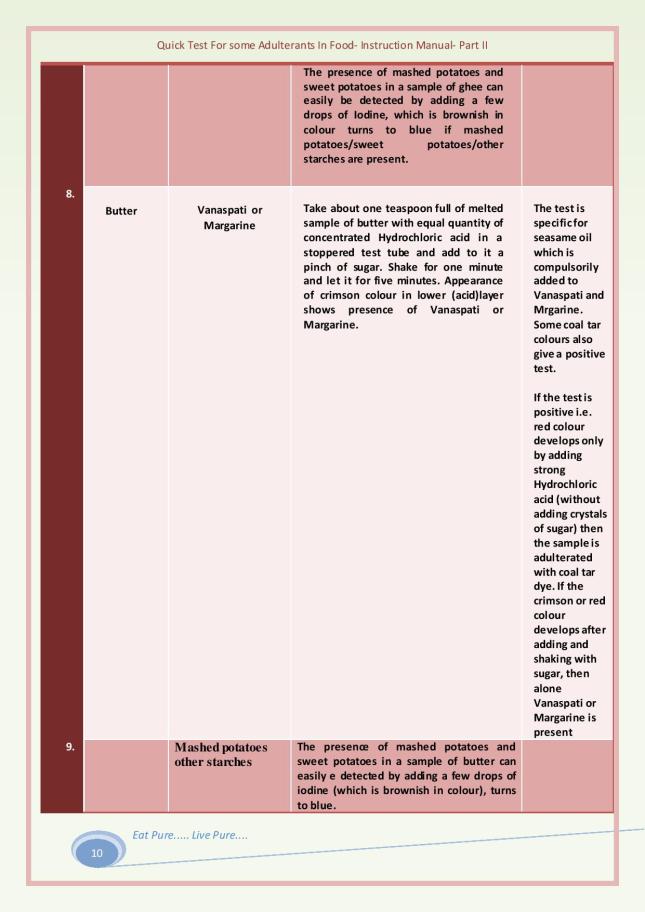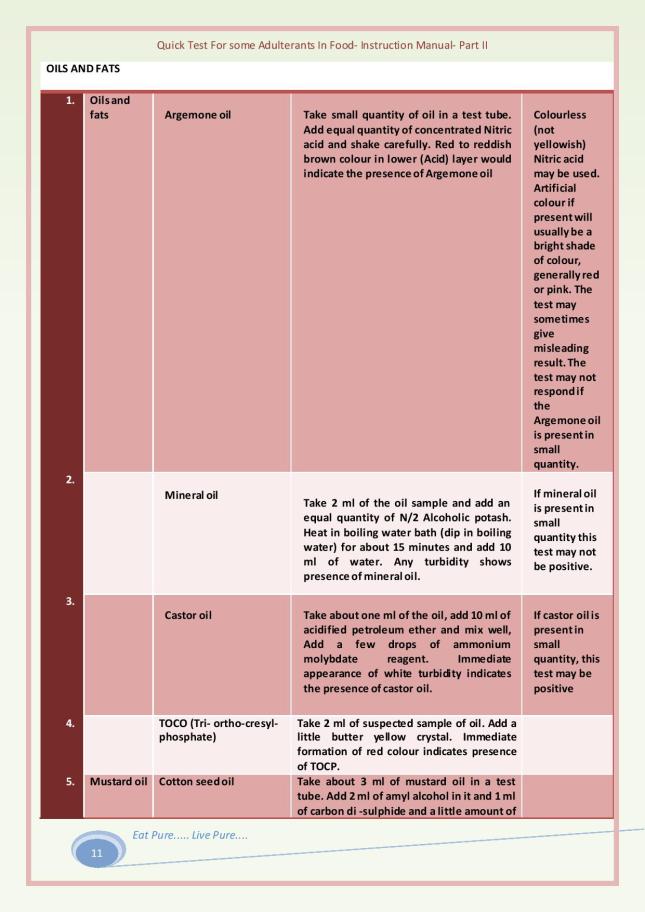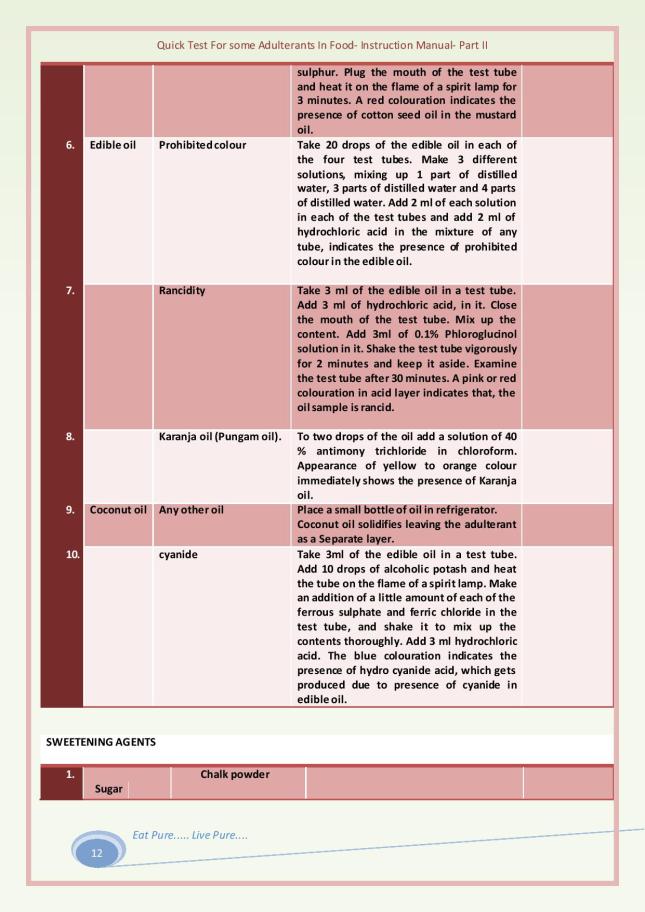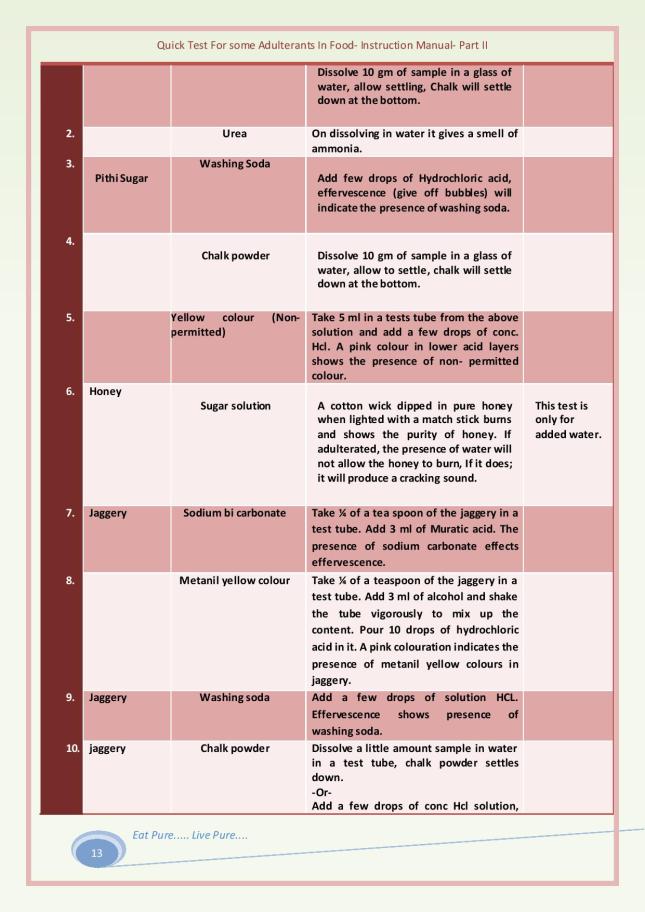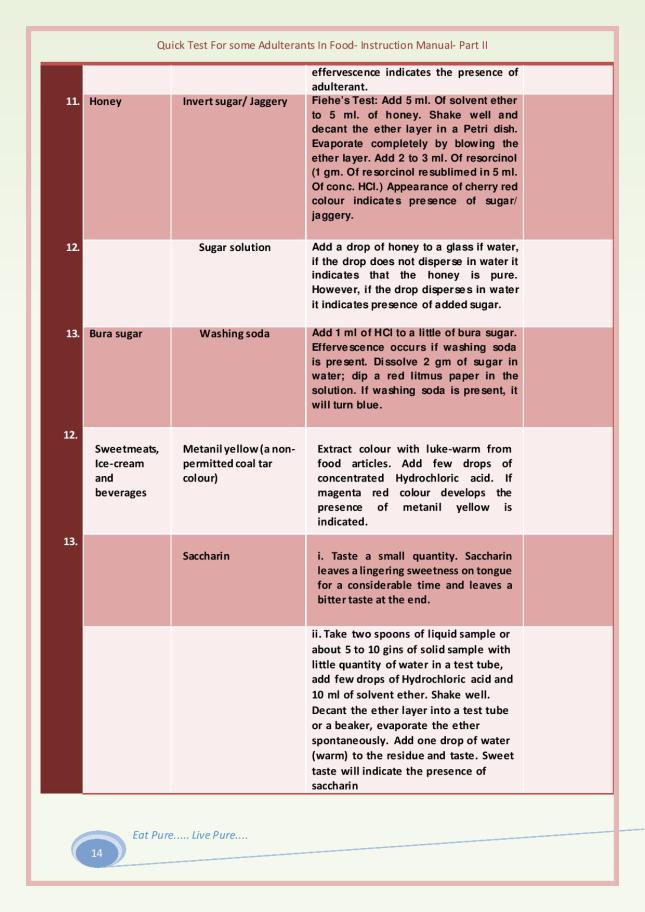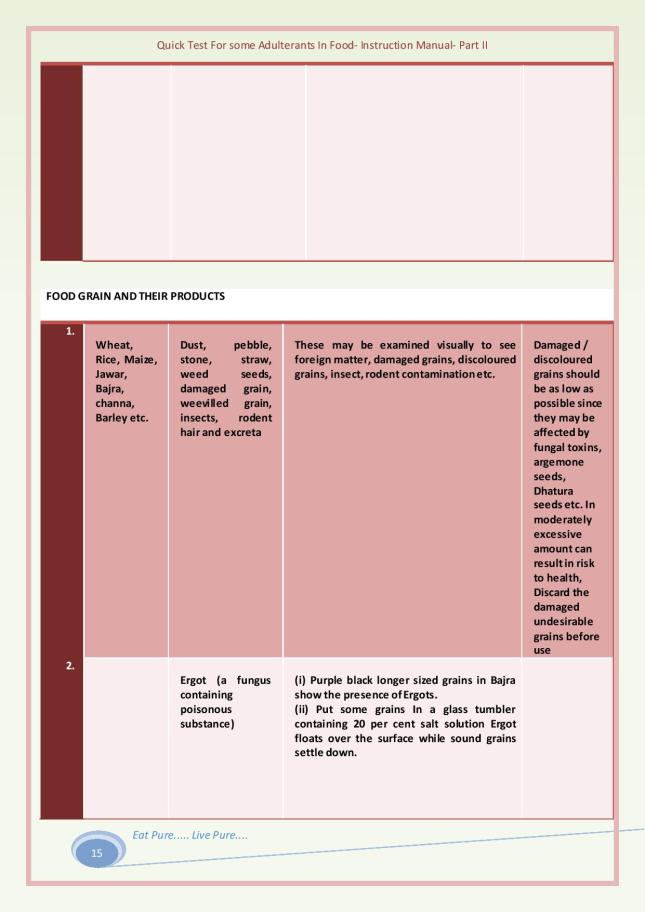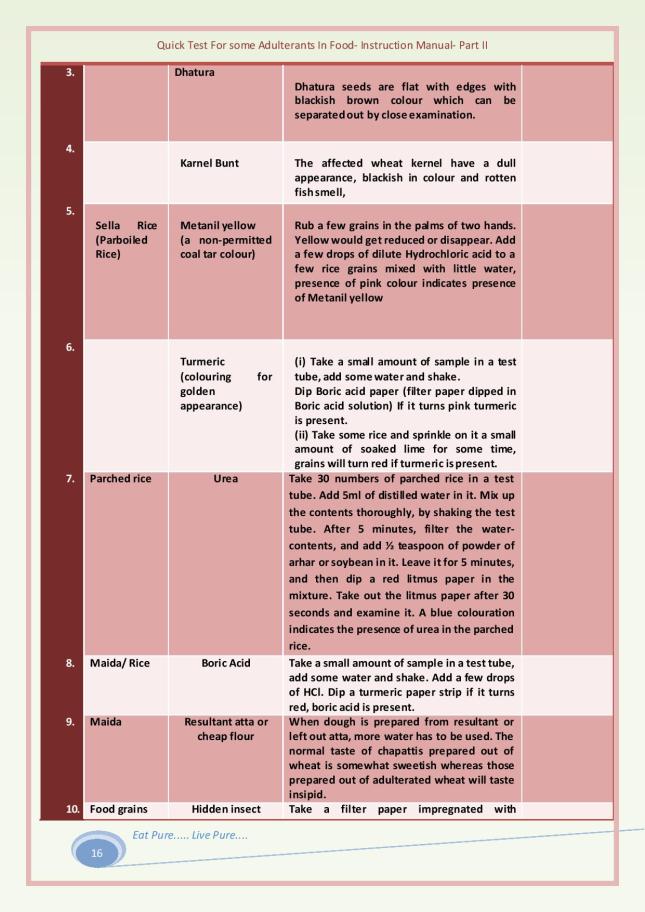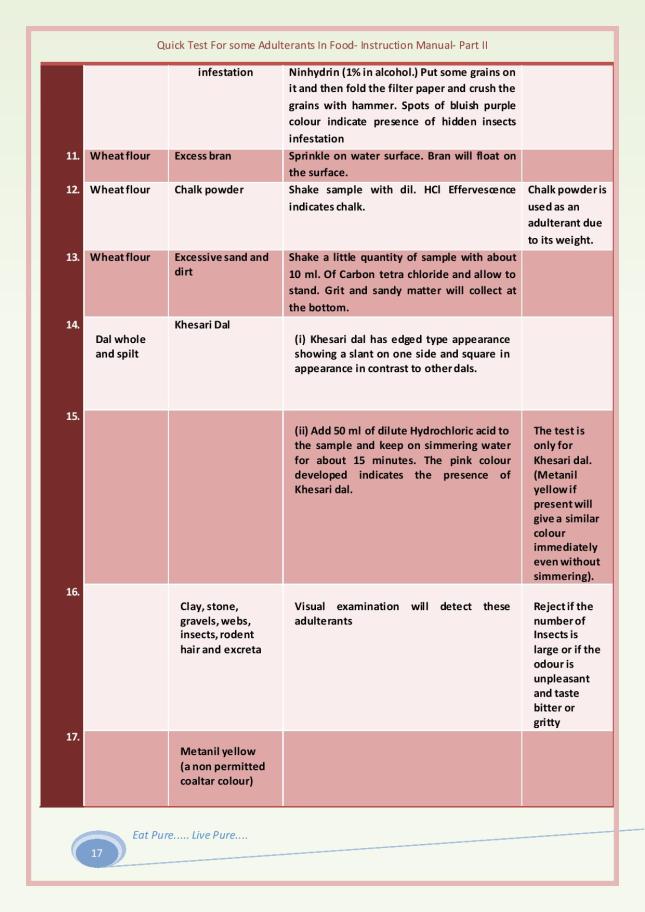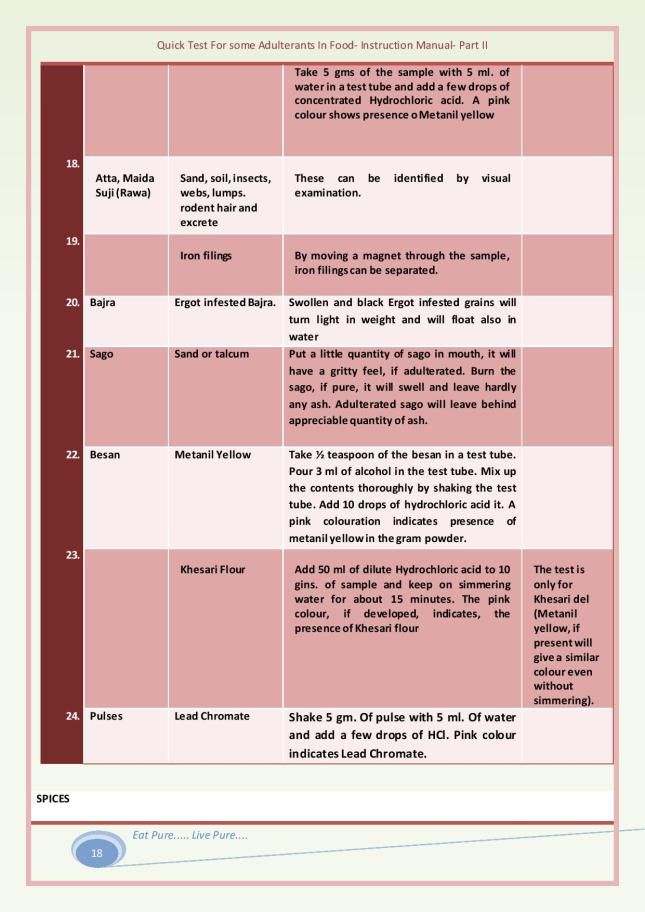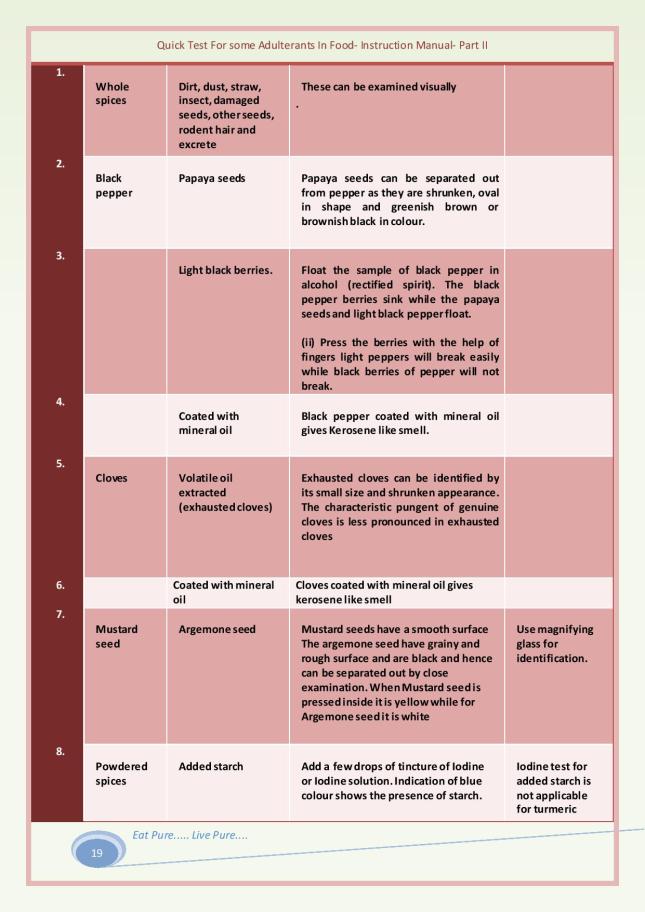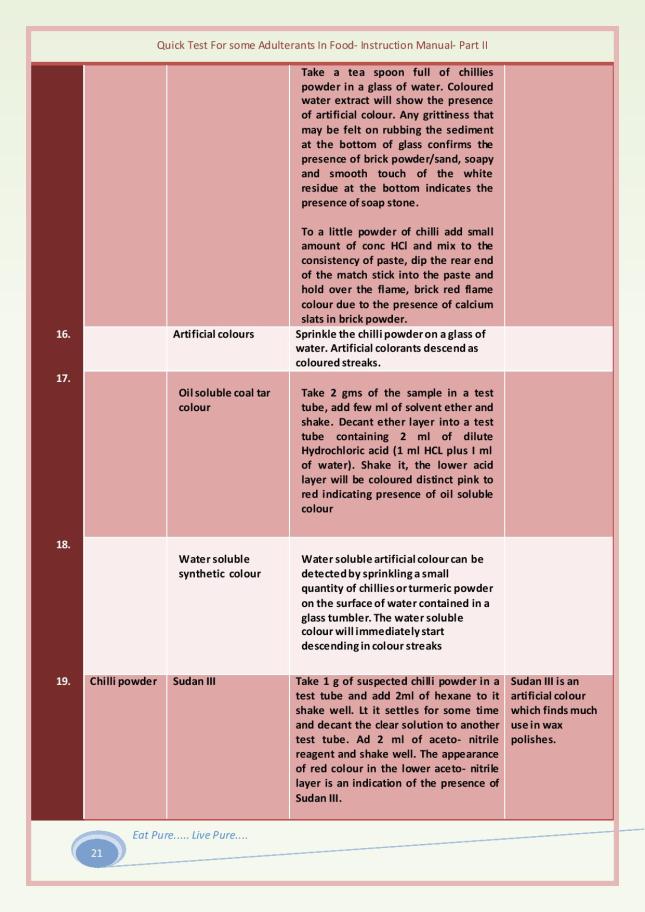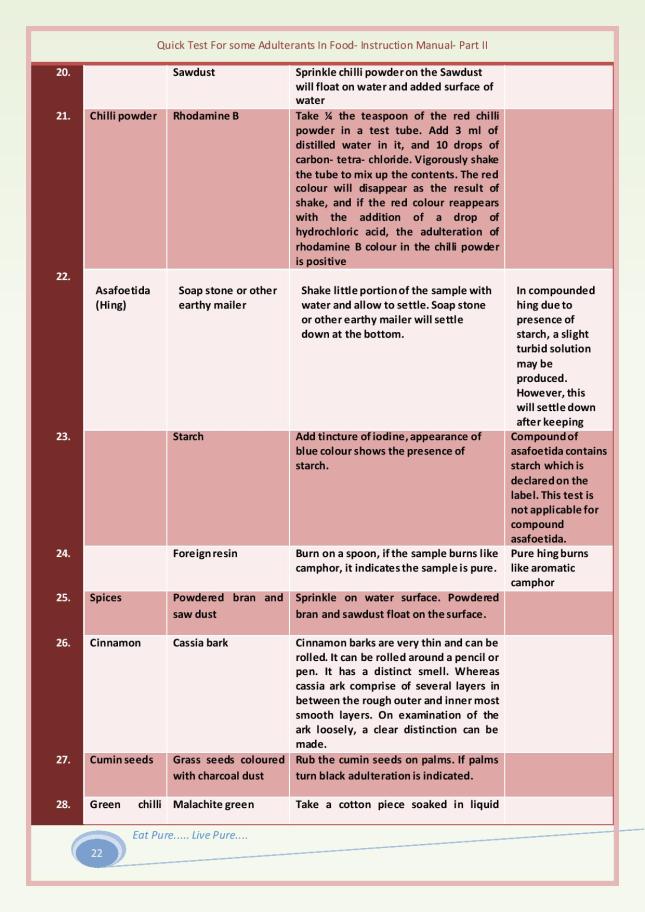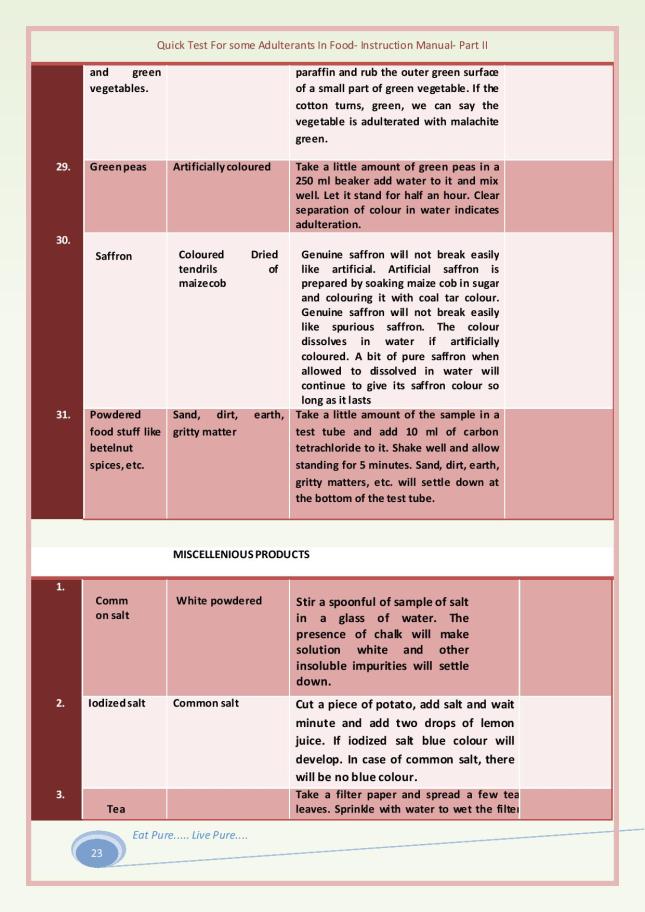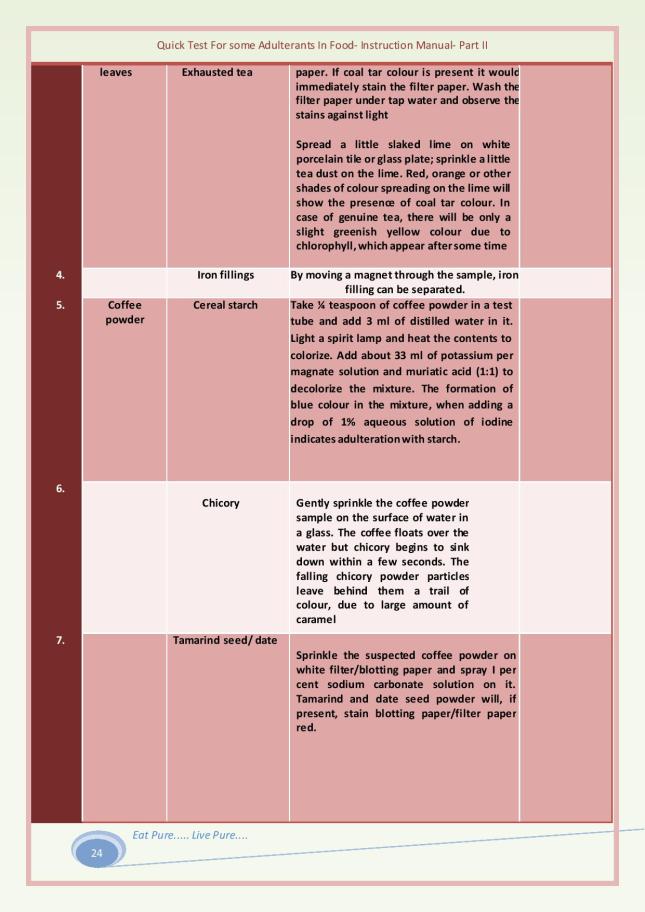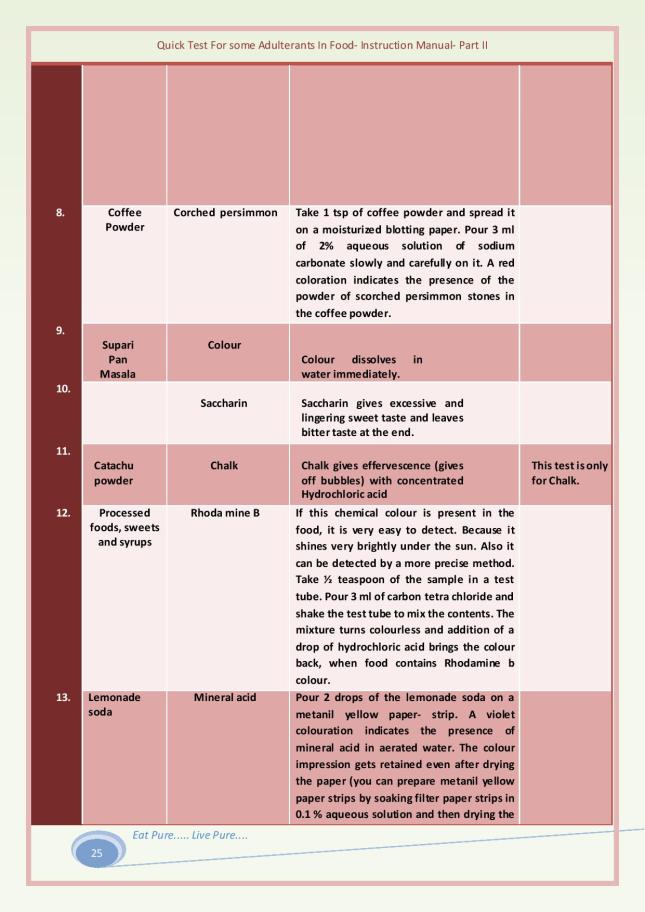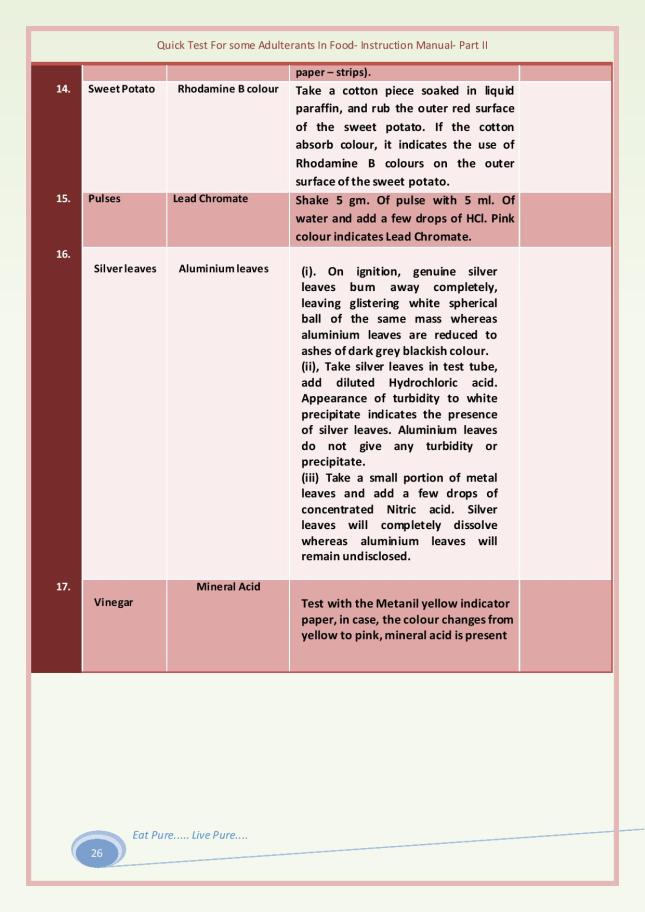FSSAI take on common food adulterants
Recently, the Food Safety and Standards Authority of India (FSSAI) prepared a document that would be useful to householders while detecting common adulterants in food. Adulteration is not only an unethical practice, but also a serious risk to our health. The manual provides the testing methodology for adulterants.
FSSAI stated, “Consumers do not have sufficient knowledge about the purity and quality of the food articles they consume. Mere visual inspection does not serve the purpose, especially when adulteration has assumed a high degree of sophistication. With this view, we have developed ‘Quick Test for Some Adulterants in Food’, so consumers can screen their food articles.”
The manual, whose tagline is ‘Eat Pure…..Live Pure….’, describes adulteration of food as “a deep-rooted social evil”. It goes on to explain that among man’s everyday needs, food plays a key role – sustenance. From a simple dish to the most lavish spread, food preparation is as varied and rich as our tastes.
It added, “The lure of riches and the general apathy (of those who indulge in such unscrupulous practices) towards mankind has led to adulterants being added to food. These range from stones in rice to the toxic brick and boric powder.” Adulteration of food is defined as the addition or subtraction of any substance to or from food, so its natural composition and quality is affected.
Adulteration may either be intentional (by removing substances from food or altering its existing natural properties knowingly) or unintentional (which is usually attributed to the ignorance, carelessness or lack of facilities for maintaining the quality of food). Be it intentional or unintentional, the common man suffers because the food is consumed without thorough checks.
“Milk and milk products, atta, edible oils, cereals, condiments (whole and ground), pulses, coffee, tea, confectionery, baking powder, non-alcoholic beverages, vinegar, besan and curry powder are the most common adulterated foods. Consumer awareness is the remedy for eliminating the evil of adulteration and the sale of sub-standard food articles,” the country’s food regulator said.
“Two parts of the instruction manual have been developed, namely Part-I and Part-II. Part-I (which contains all the following instructions) incorporates simple testing procedures which can easily be performed at home and simply helps the consumers screen their day-to-day food articles,” it said.
“Part-II incorporates testing procedures which require specific chemicals, reagents and glassware and cover a wider range of adulterated food group. The scope of this manual is limited to small industries, food vendors, non-governmental organisations (NGOs), etc., but for detailed confirmatory tests and quantification, analysis in a laboratory is a must,” the manual stated.
Adulteration simplified
Food is one of the basic necessities of life. Although we work hard and earn to satisfy our hunger, we are usually not aware of what we consume. We may actually be eating a dangerous dye, sawdust, soapstone, industrial starch or aluminium foil! Contaminated food and drink are sources of infection, which can be avoided.
Food adulteration is an act of intentionally debasing the quality of food offered for sale by the admixture or substitution of inferior substances or by the removal of some valuable ingredient. An adulterant is any material which is or could be employed for making the food unsafe or sub-standard or misbranded or containing extraneous matter.
Food adulteration takes into account not only the intentional addition or substitution or abstraction of substances which adversely affect the nature, substance and quality of foods, but also their incidental contamination during the period of growth, harvesting, storage, processing, transport and distribution.
Food is adulterated if its quality is lowered or affected by the addition of substances which are injurious to health or by the removal of substances which are nutritious. Adulterated food is dangerous because it could be toxic and could deprive food of the nutrients essential for proper growth and development.
Food is declared adulterated if:
a substance is added which depreciates or injuriously affects it
cheaper or inferior substances are substituted wholly or in part
any valuable or necessary constituent has been wholly or in part abstracted
it is an imitation
it is coloured or otherwise treated to improve its appearance or if it contains any added substance injurious to health
for whatever reasons its quality is below the standard
More often than not, food is adulterated by merchants and traders who want to make a quick profit. But sometimes, shortages and increasing prices, consumer demands for variety in foods, a lack of awareness, negligence, indifference and lethargy among consumers and inadequate enforcement of food laws and food safety measures also lead to food adulteration.
Types of adulterants
Intentional adulterants: Sand, marble chips, stones, mud, other filth, talc, chalk powder, water, mineral oil and harmful colour
Incidental adulterants: Pesticide residues, droppings of rodents and larvae in foods
Metallic contaminants: Arsenic from pesticides, lead from water, effluents from chemical industries and tin from cans
Poisonous or deleterious substances
If a food contains a poisonous or deleterious substance that may render it injurious to health, it is adulterated. Examples are apple cider contaminated with E. coli O157:H7 and Brie cheese contaminated with Listeria monocytogenes. Mixing a poisonous substance in excess of a tolerance limit, regulatory limit or action level to reduce the level of contamination is not permitted.
Sometimes, adulterated food is deliberately mixed with good food. This renders the finished product adulterated.
Filth and foreign matter
Filth and extraneous material include any objectionable substances in foods, such as foreign matter (such as glass, metal, plastic, wood, stones, sand and cigarette butts), undesirable parts of the raw plant material (such as stems, pits in pitted olives, pieces of shell in canned oysters) and filth (namely mold, rot, insect and rodent parts, excreta and decomposition).
Economic adulteration
A food is said to be adulterated if it omits a valuable constituent or substitutes another substance, in whole or part, for a valuable constituent (for example, if olive oil is diluted with tea tree oil); conceals damage or inferiority in any manner (such as fresh fruit with food colouring on the surface to conceal defects); or any substance has been added to it or packed with it to increase its bulk or weight, reduce its quality or strength, or make it appear bigger or of greater value than it is (for example, adding water to scallops to make them heavier).
Microbiological contamination and adulteration
The fact that a food is contaminated with pathogens (harmful micro-organisms such as bacteria, viruses or protozoa) may or may not render it adulterated. Generally in a ready-to-eat food, the presence of pathogens will render the food adulterated. Salmonella in fresh fruit and vegetables or ready-to-eat meat or poultry products such as luncheon meats is an example.
For meat and poultry products, which are regulated by the United States Department of Agriculture (USDA), the rules are more complicated. Ready-to-eat meat and poultry products contaminated with pathogens, such as salmonella or Listeria monocytogenes, are adulterated (because raw meat and poultry products are intended to be cooked and only proper cooking will kill the pathogens). Raw poultry contaminated with salmonella is not adulterated.
Methods for detection of common adulterants in food
[Note: These include items mentioned in both Part-I and Part-II of the instruction manual.]
Water in milk
This is the most common example of adulteration. To detect the presence of water in milk, place a drop of milk on a polished slanting surface. A drop of pure milk will flow slowly, leaving a white trail in its wake, whereas milk that’s been adulterated with water will flow immediately without leaving a mark.
Other adulterants in milk
Starch
A few drops of iodine tincture or solution are added to the milk. If its turns blue, starch is present in it.
Urea
A teaspoon of milk is put in a test tube, and half-a-teaspoon of soybean or arhar powder is added to it. The contents are mixed by shaking the test tube well. After about five minutes, a red litmus paper is dipped in it, and removed about 30 seconds later. If the litmus paper turns blue, urea is present in the milk.
Vanaspati
About 3ml of milk is taken in a test tube and about ten drops of hydrochloric acid are added to it. A teaspoonful of sugar is added to the mixture. After about five minutes, the mixture is examined. The red colouration indicates the presence of vanaspati in the milk.
Formalin
Formalin enhances the life of milk and is thus added for the purpose of preservation. About 10ml of milk in a test tube and about 5ml of concentrated sulphuric acid is added from the sides of the wall without shaking it. If a violet or blue ring appears at the intersection of two layers then it shows the presence of formalin.
Detergent
About 5-10ml of the milk sample is mixed with an equal amount of water lather. When shaken, it indicates the presence of detergent.
Synthetic milk
Synthetic milk has a bitter after-taste, gives a soapy feeling when rubbed between the fingers and turns yellowish on heating.
Synthetic milk – test for protein
The milk can be tested by using Urease strips. Synthetic milk is devoid of protein.
Test for glucose/inverted sugar
If a test for glucose with a Urease strip has a positive result, the milk does not contain glucose or inverted sugar. If it is made synthetically by adding by adding white coloured water paint, oils, alkali, urea, detergent, etc. Glucose or inverted sugar syrup is added in milk to increase the consistency and taste.
Ghee, cottage cheese, condensed milk, khoa, milk powder, etc.
About 5ml of diluted H2SO4 or concentrated HCl is added to one teaspoon full of the melted milk sample in a test tube and shaken well. If it turns pink (in case of H2SO4) or crimson (in case of HCl) it indicates the presence of coal tar dyes. If HCl does not give a colour, it can be obtained by diluting it with water.
Dairy products
Sweet curd
A tablespoonful of curd is taken in a test tube and about ten drops of hydrochloric acid are added to it. The contents are mixed by shaking the test tube gently. After about five minutes, if upon examination, it is observed that the mixture has turned red, the curd contains vanaspati.
Rabri
A teaspoon of rabri is taken in a test tube and about 3ml of hydrochloric acid and 3ml of distilled water are added to it. The contents are stirred with a glass rod, which is then removed. If, upon examination, the rod is found to have fine fibres, it shows the presence of blotting paper in rabri.
Khoa and its products
A small quantity of a khoa sample (or the sample of a product containing khoa) is boiled in water and cooled. A few drops of iodine solution are added it. If it turns blue, it indicates the presence of starch.
Chhana/paneer
A small quantity of a chhana or paneer sample is boiled in water and cooled. A few drops of iodine solution are added it. If it turns blue, it indicates the presence of starch.
Oils and Fats
Ghee/butter
About a teaspoonful each of melted ghee and concentrated hydrochloric acid are taken in a stoppered test tube and a pinch of sugar is added to it. It is shaken for about a minutes and left for about five minutes. If the acid turns crimson, it indicates the presence of vanaspati or margarine.
The test is specific to sesame oil, which is added to vanaspati and margarine, Some coal tar colours also give a positive test. If the test is positive (i.e. if the acid turns red) only by adding strong hydrochloric acid (without adding crystals of sugar) then the sample is adulterated with coal tar dye. If the red colour appears after the sugar is added and the mixture is shaken, then only vanaspati or margarine is present.
Mashed potatoes, sweet potatoes and other starches
A few drops of iodine are added to a ghee sample. Iodine, which is brownish in colour, turns blue if the sample contains mashed potatoes, sweet potatoes or other kinds of starches.
Edible oil
About 5ml of edible oil is taken in a test tube and about 5ml of hydrochloric acid is added to it. It is shaken gently and then let to stand for about five minutes. The adulterant (prohibited colour) and the oil will separate, and the former will form the upper layer.
Coconut oil
A small bottle of oil is placed in the refrigerator. Upon solidifying, the adulterant (any other oil) forms a separate layer.
Sweetening agents
Sugar
Chalk
About 10gm of sugar is dissolved in a glass of water and allowed to settle. Chalk will settle at the bottom.
Urea
Upon dissolution in water containing sugar, urea gives the smell of ammonia.
Non-permitted yellow colour
About 5ml of water containing sugar is taken in a test tube, and a few drops of concentrated HCl is added to it. If the lower layers of the acid turn pink, it indicates the presence of non-permitted colour.
Honey
A cotton wick is dipped in pure honey. Upon lighting it with a matchstick, it will burn and show the purity of honey. The presence of water (one of the two ingredients in a sugar solution) will not allow the honey to burn. If it does, it will produce a cracking sound. This test is only for added water.
Jaggery
Washing soda
A few drops of solution HCl is added to jaggery. Effervescence indicates the presence of washing soda.
Chalk powder
Jaggery is dissolved in water. If it settles down, it indicates the presence of chalk powder.
Alternately, a few drops of concentrated HCl are added to the jaggery. Effervescence indicates the presence of the adulterant.
Metanil yellow colour
A quarter of a teaspoon of jaggery is taken in a test tube. About 3ml of alcohol is added to it and the test tube is shaken vigorously to mix the content. About ten drops of hydrochloric acid are added to it. A pink colour indicates the presence of metanil yellow (a non-permitted coal tar colour) in jaggery.
Sugar solution
A drop of honey is added to a glass of water. If it does not disperse in the water, the honey is pure; but if it does, it indicates the presence of added sugar.
Bura sugar
About 1ml of HCl is added to little bura sugar. If washing soda is present, effervescence will occur. About 2gm of sugar is dissolved in water, and red litmus paper in the solution. If washing soda is present, it will turn blue.
Sweetmeats, ice cream and beverages
Colour is extracted from food articles using lukewarm water. A few drops of concentrated hydrochloric acid is added to it. A magenta colour indicates the presence of metanil yellow.
Saccharin
A small quantity of a sweetmeat, ice cream or a beverage is tasted. Saccharin leaves a sweet taste in the mouth for a long time, but it eventually tastes bitter.
Foodgrains
Wheat/rice/maize/jawar/bajra/chana/barley, etc.
These may be examined visually to see foreign matter, damaged grains, discoloured grains, insects, rodent contamination, etc.
Common adulterants in foodgrains include dust, pebbles, stones, straw, weeds, seeds, weevilled grain, insects, rodent hair and excreta.
Damaged or discoloured grain should be as low as possible since they may be affected by fungal toxins, argemone seeds, dhatura seeds, etc. A moderately excessive amount can result in risks to health. The damaged, undesirable grains should be discarded before use.
Maida
When dough is prepared from the resultant or left-out atta, more water has to be used. The normal taste of chapatis prepared out of wheat is slightly sweet, whereas those prepared from adulterated wheat will taste insipid.
Maida/rice
A small amount of maida or rice is taken in a test tube, some water is added to it and it is shaken. A few drops of HCl are added to it. A turmeric paper strip is dipped in it. If it turns red, boric acid is present.
Wheat/bajra and other grains
Ergot
(i) Purple black longer-sized grains in bajra show the presence of ergots (fungi that contain poisonous substances)
(ii) Some grains are put in a glass tumbler containing 20 per cent salt solution (20gm common salt to 100ml water). Purple black longer-sized grains of ergots floats over the surface, while the sound grains settle down
Dhatura
Dhatura seeds are flat with blackish-brown edges that can be separated upon close examination.
Burnt kernel
The affected wheat kernel has a dull appearance, is blackish in colour and smells like rotten fish.
Sella rice (parboiled rice)
Metanil yellow
When a few grains of sella rice are rubbed in the palms of both hands, the yellow colour is reduced or disappears. When a few drops of diluted hydrochloric acid are added to a few rice grains mixed with a little water, the presence of the pink colour indicates the presence of metanil yellow.
Turmeric (a colour used for the golden appearance)
(i) A small amount of sella rice is taken in a test tube, some water is added and it is shaken. If, upon dipping boric acid paper (filter paper dipped in boric acid solution), it turns pink, turmeric is present
(ii) Some rice is taken and a small amount of soaked lime is sprinkled on it for a while. If turmeric is present, the grains will turn red

